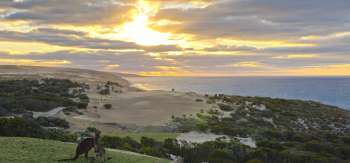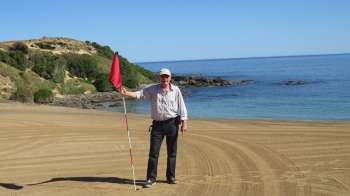Jeju Winds hold the key to CJ Cup scoring
18 Sep 2018
Media Release: Jeju Island, South Korea
When the U.S. PGA Tour visited The Club at Nine Bridges last year for the inaugural C.J. Cup, the October event punctuated nearly 20 years of strategic design tweaks from course architect David Dale. With the second CJ Cup schedule for Oct. 18-21, such prep is largely done and dusted -- fitting for a course that so impressed players, Tour officials and a worldwide television audience.
But the reality is, a sizable chunk of last year’s compelling impressions relied on something quite ephemeral: the trade winds that materialized here on Jeju Island over the weekend. These breezy conditions Friday-Saturday-Sunday kept the 2017 field from going low (Justin Thomas won at 9 under par, besting Marc Leishman in a playoff), while revealing the track’s strategic teeth.
“I think we were all very pleased with what we saw. It was a great event. But I think the Jeju Winds definitely helped,” says Steve Wenzloff, vice president and player liaison with PGA TOUR Design Services. “The winds here are more than an element. They’ve been factored into the design in quite specific ways. We were fortunate to see that play itself out over the weekend last year.”
The Club at Nine Bridges -- located on Jeju Island, some 7 miles off the Korean peninsula’s southern coast -- is merely the latest elite club whose competitive reputation rests on its ability to conjure windy conditions during tournament week. The course’s design reputation is secure (GOLF Magazine’s World Top 100 list ranks Nine Bridges at #41; Golf Digest rates it #79 on the planet, #23 in its list of courses outside the U.S.). But without the Jeju Winds, it’s something of a sitting duck, like every other course the Tour frequents.
“This isn’t exactly news, but these Tour guys are incredibly good,” said Nine Bridges course architect Dale, a partner with Santa Rosa, Calif.-based Golfplan. “At its Open venues, the USGA chooses rough, fairway width and green speed to defend par. That’s why, when the wind does come up, it can get a little crazy out there -- like we saw on Saturday at Shinnecock in June.
“At Nine Bridges, we’ve tried like the dickens to use design elements to create that resistance to scoring -- but we did so with the Jeju Winds (and how they traditionally blow in October) firmly in mind. The proof is in the pudding: The golf course, with the wind blowing, defended par. I’m pretty sure Justin Thomas shot 9-under the first day [he did in fact go 63-74-70-72]. Then the wind showed up. The winning score was 9-under. Bingo.”
Dale says some of these design elements are straightforward. He created a new back tee on the par-5 18th, for example, to ensure that players going for that green in two would have at least a 250-yard approach shot -- to cover the bunker guarding the island green. On Sunday, when Jeju’s trade winds were blowing in the players faces, that’s exactly the risk/reward approach shot both Thomas and Leishman were obliged to make, twice -- once in the regulation, then again in the playoff.
“Without the wind blowing as it normally does, both those guys are hitting mid-irons,” Dale says. “There’s a similar but more nuanced equation playing out on several holes at Nine Bridges. At 16 [a Cape-style, bite-off-what-you-dare par-4 measuring 427 yards], the position of the fairway bunkers that form the Cape element -- and where fairway gets narrow in the landing area -- are calibrated very specifically to lure players into a potentially hazardous/rewarding shots off the tee. But it’s all based on the prevailing wind being up -- so I say, Let it blow!”
Dale, who remembers hitting a persimmon driver when the course was christened, in 2001, acknowledges the cat-and-mouse nature of defending par against such skilled players, armed with state-of-the-art technology.
“I’d say the 6th hole was too easy for them,” Dale says of the 428-yard par-4. “They blew it right over my spectacle bunkers! We still plan to pull the tees back 15 yards, to make them more relevant. But no. 8” -- a driveable par-4 with its Het Girdle green, one of several homages here to the King’s Course at Gleneagles, in Scotland -- “was very exciting. To see Justin Thomas hit it through the green and make 4, to see K.J. Choi nearly drive the green and walk away with 7? I imagine that was as fun for me as it was for everyone watching on TV.”
On some level, the balancing act Dale describes takes place at most every Tour stop, the world over. But Wenzloff explains that terrain and design make the formula especially nuanced at Nine Bridges, for which there are few comps in the world of tournament golf.
“The course is great and what we did prior to last year’s event has worn very well,” Wenzloff says. “The routing is very good. It sits in there very well and on the terrain. David [Dale] didn’t move a lot of dirt, which is unusual for Korea or any mountain golf course -- but it is a mountain course. I think the best comparison on Tour is Kapalua [home to the Tournament of Champions each January]. At Kapalua, because of the topography, the trade winds uniquely affect the competition there.”
As it happens, Justin Thomas won the 2017 Tournament of Champions at 22 under. Dustin Johnson prevailed at last January’s tourney, shooting -24. As Wenzloff notes, the Plantation Course at Kapalua was also designed to function in strong trade winds (the 18th hole there traditionally plays downhill and downwind some 660 yards -- players routinely hit it in two). But the balance is a fine one. Johnson won his first ToC there in 2013, when the event was shortened to 54 holes because inordinately strong trade winds rendered the course unplayable for three days.
Barring freak storm conditions, Dale doesn’t see that ever happening at Nine Bridges: “But what I think the CJ Cup and Kapalua show us is how precariously the competitive equation is perched at certain tournament courses. We’ve seen how wind can suspend play on British Open courses as well -- when the ball is being blown around on the greens. That situation isn’t ideal, but we need to acknowledge that up until that point when it gets out of hand, it might be the most compelling tournament golf there is.”
Back to News
0 Comments
More News
The Cliffs Kangaroo Island Announces Preview Play in early 2026
Major milestone for stunning new destination course with preview play available from January 2026
Who Really Designed Cape Wickham Links?
AGD ranks Cape Wickham #1 in Australia & interviews Duncan Andrews to get full story on course design
Cape Wickham Links – The Inside Design Story
Co-designer Darius Oliver reveals the truth behind the design of Australia’s premier modern golf course
2025 Karrie Webb Series scholars announced
Two young golfers set to follow in the footsteps of some of Australia's best golfers after winning 2025 scholarships





